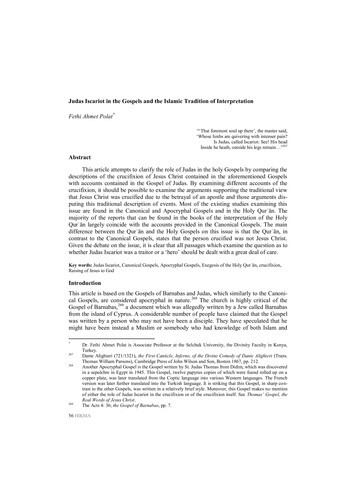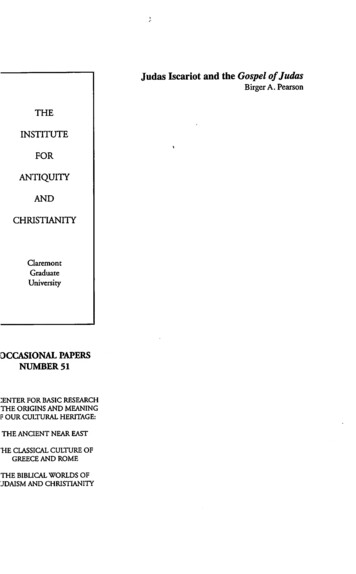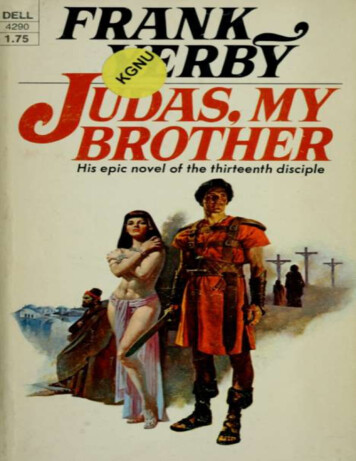
Transcription
Hopefor JudasGod’s Boundless Mercy for Us AllChristoph Wrembek, S.J.
Published in the United States by New City Press202 Comforter Blvd., Hyde Park, NY 12538www.newcitypress.com 2021 New City Press (English translation)Translated by Marianne Hessingfrom the original German edition Judas, der Freund 2019 Neue Stadt Verlag, Munich, GermanyUnless otherwise indicated, scripture quotations are taken from theNew Revised Standard Version Bible, copyright 1989 NationalCouncil of the Churches of Christ in the United States of America.Used by permission. All rights reserved worldwide.Cover photo by Jean-Claude Gadreau, Vézelay 2021 Cover design and layout by Miguel TejerinaLibrary of Congress Control Number: 2020952426ISBN: 978-1-56548-381-1ISBN: 978-1-56548-383-5 e-bookPrinted in the United States of America
ContentsA word to the readers. 7Introduction. 9Jesus and the woman who was divorced five times . 17In Hades – or: through fire . 43Jesus’ parables of the three “lost ones”. 64Excursion – Putting our life in order. 81God gives his salvation. 97Judas, the friend. 103The secret of the “Good Shepherd of Vézelay”. 121Epilogue. 129Questions and AnswersWhat about repentance and conversion?. 132The freedom of the human person. 135Damnation: an article of faith?. 141“Hell” in the Bible. 144Redemption for all?. 146The “son of destruction”?. 150“For many” – “For all”?. 153‘The Good Shepherd of Vézelay’. 158Acknowledgements. 160
A word to the readersThe little book offers more than you might assume atfirst glance. Maybe you found the title to be somewhatsurprising: “Hope for Judas” . . .Judas? The son of destruction?Judas, about whom the Gospels tell us very littlebeyond the dramatic events in the course of the Passion, inhim, Jesus’ loving-saving action finds its culmination?Drawing from a depiction on the beautifully carved topof a column (in architectural terms, a capital1) in the medieval Basilica of St. Mary Magdalene in the town of Vézelay,France, much is awaiting you: a breathtaking, enlighteningand, no doubt, oftentimes touching journey through different core stories of sacred scripture. Stories about being lost,but ultimately always stories about salvation. Be patient andlet yourself be taken on a tour into the soul of the Gospel,which is Jesus himself. A treasure chest of faith, of spirituality and of direction might open for your life.What does the book offer you? You will come to knowthe fascinating story of the origin of this capital, you will1.A “capital” is the upper part, or the head, of a pillar or column.The term derives from Latin capitellum, literally “little head.” Forimages of the capital in Vézelay, turn to the picture on page 127,and the close-up picture on the bottom of page 15.7
Hope for Judasaccompany Jesus in his encounter with the woman at Jacob’swell, and you will discover in a new way the parables of thethree “lost ones” – the lost son, the lost sheep and the lostcoin. You will find out that there is much to be discoveredin Jesus’ interactions with Zacchaeus, with the tax collector,and with the crippled woman.All these encounters and stories can be read in view ofJudas. In all of them, the motif of salvation shines through,salvation for even the most lost soul of all, because theCreator does not give up on anyone.Salvation and redemption, therefore, also for Judas? Atthe end of this booklet you will find a surprising answer.Wonderful and heartening. Carved in stone in the uniquedepiction of the “Good Shepherd of Vézelay.” Visible to theeye, palpable to the heart.Therein lies an incredible hope. Whichever way ourown life may have taken, with all its inconsistencies, we,too, may be able to say in the end: “You, who have takenJudas home, carry me, too!” And if we are not able to bringourselves to say these words – HE carries home also the onewho cannot speak. Everyone. Me, too.8
IntroductionFor years, I have been captivated by a picture. It occupies a prominent place in my study. It accompanies mythinking and my musing, my theological reflecting, andmy personal prayer. It nourishes my loving and, like a deepwell, is ever new. The picture shows a capital, the artisticallycarved top of a column. It is found in the Romanesque abbeychurch of St. Mary Magdalene in the town of Vézelay, inBurgundy, France. On the left side of the artistic depictionwe see Judas who has hanged himself, and to the right, ashepherd who carries the dead Judas over his shoulder, likethe lost sheep. I call it “the Good Shepherd of Vézelay.” Itbecame the inspiration for this book.Almost 900 years old, this medieval capital deservesmore than just a quick glance. It deserves all our attentionbecause it contains the whole of God’s message of salvationand redemption. We are seeing the very being and the veryheart of Christian theology, in a way words could not convey any more beautifully, any more powerfully, or any moretouchingly.Just think: In earlier centuries, people had neither binoculars nor cameras. Surely only very few would even havelooked up that far to the top of a column, in the shadow ofthe ceiling. There were many other images to look at, bathedin more light than this one. The unknown sculptor of thiscapital, his senses imbued with a faith yearning for truth,had created something that remained unnoticed, hidden inthe protective shadow. It was too high and too distant.9
Hope for JudasIn our days this seemingly plain yet profoundly expressive image of our faith gets much more attention. It adornsbooklets or serves as an image for meditation for those whoare searching. Important experts did discover it but didnot “notice” its significance. In many art guides, it is noteven mentioned since there seems to be nothing importantin it. Other capitals in the Basilica of St. Mary Magdaleneseem more interesting, even though their themes and symbolic meaning are often not easily understood. Instead,the message of this depiction is immediately evident. TheGood Shepherd, Jesus, as he identified himself, is carryingJudas home like the lost sheep. Most scenes on the church’scapitals capture themes from the Old Testament or frommythology, but this well-known motif of Jesus, the GoodShepherd, undoubtedly belongs to the New Testament.This unfamiliar and unusual depiction can be contrasted with another image of Judas. This other image isfound only fifty-six miles southeast of Vézelay in the churchof St. Lazarus in Autun, built around the same time as theBasilica of St. Mary Magdalene, between 1120 and 1140CE. The patrons of the two churches, Mary Magdalene andLazarus, were siblings but the two depictions of Judas inthem have nothing in common! In the school of Gislebert,the sculptor who so richly decorated St. Lazarus, Judas isdepicted as hanged and at his feet, on his right and left,two satanic demons hungrily crave their prey. In the Vézelaybasilica, the unknown sculptor shows the opposite. He doesnot depict Satan and his demons taking the hanged Judas asprey with them to hell, but rather the Good Shepherd whocarries Judas home like a trophy.In Vézelay, an overall plan for the images in St. MaryMagdalene has never been found, but the preparatory workfor the capitals is assumed to have been done by a significantscholar of the time. Research points to Peter the Venerable,10
Introductionan impressive personality of his century. At age twenty-one(in 1115) he was named Prior of the Cloister in Vézelay, andat twenty-eight he became the ninth abbot of the AbbeyCloister of Cluny, the center of the medieval renewal movement of monastic life. He had great human sensitivity, wasdeeply pious and theologically outstanding (he had theQur’an translated into Latin), and he gave asylum in Clunyto another brilliant loner of his time: Peter Abelard.If Peter the Venerable indeed gave inspiration to thecapitals, we need to ask if Peter Abelard’s life-journey couldhave been a vivid inspiration for this unique depiction ofJudas. So, allow me to take you on an expedition, a briefsummary of this fascinating story.Abelard prided himself in being a great philosopher and master in dialectics, the debating of the truthof opinions. In 1115, he taught in Paris. The great crowdsof students who followed him confirmed him in his vainself-image. This necessarily led to opposition, even moreso since Abelard attempted to integrate reason with faith.Among his students was Héloïse, extremely gifted intellectually as well as extraordinarily beautiful, the niece of theinfluential Canon Fulbert. She, too, admired and adored thephilosopher. After an initial serious, morally correct teacher-student relationship, Abelard discovered that aside fromdialectics and logic, sensual pleasures had also awakened inhim. Thus, Héloïse and Abelard became one of the mostfamous, most scandalous, and most incomprehensible pairof lovers in history. Both were aflame for each other withbody, spirit, and soul. Héloïse loved him from the beginningwith a passionate (and as time would show), lifelong andunconditional love. They soon became a couple.When she bore him a son, Abelard sent her away to hisfamily. His sensuality had not grown into responsible loveeven though, to appease Fulbert, he married Héloïse sacra11
Hope for Judasmentally. In punishment for what Abelard had done to hisfamily’s reputation, Héloïse’s outraged father clandestinelysent men to have him castrated.At Abelard’s insistence, for her protection but againsther own wishes, Héloïse entered the convent. Even though farremoved and without contact for many years, her love for thebeloved never diminished. Eventually, she became the Abbessof the Paraclete Cloister, founded by Abelard.Humiliated though he was, Abelard continued teaching. In 1141, not without intrigue, and with the consent ofBernard of Clairvaux, the Synod of Sens declared Abelard aheretic. He was now a broken man, all vanity extinguished.He became known as a great sinner, a heretic excluded fromthe Church. His life was destroyed and hopeless. He initiallyplanned to go to Rome to appeal to the pope. However, heset out for Cluny where Peter the Venerable was Abbot. Hispilgrimage to Cluny led him through the town of Vézelay,where a year before the church had been completed, stillwithout the narthex (the entrance hall). We may wonder . . .did he enter there and look up to his right? Did he recognize himself in Judas, the one who in his hopelessness hadhanged himself? Did he see the shepherdtoo . . .? Yet unlikeJudas, Abelard had not handed Jesus over; he even sought,like his master, to bring reason into faith. He did not hanghimself, but public opinion of the day had “hanged” him,so to speak.He knocked at the door in Cluny and together withbeggars and pilgrims asked for a bed. But Peter the Venerablerecognized who was seeking refuge with him and welcomedhim in honor. Just one year later, on April 21, 1142, Abelarddied. Peter the Venerable had the greatness and freedom ofsoul to personally inform Abelard’s rightful wife, by nowAbbess Heloise (“my dearest sister in our Lord”) of the passingof “the man who belongs to you.” At the end of his letter to12
Introductionthe Abbess, he wrote: “He, to whom you are joined throughthe bond of the flesh, then through the firmer and strongerbond of divine love, he, with whom and under whom youconsecrated yourself to the service of God, he, I say, will todaybe embraced instead of by you, by God in love, as your otherself. And on the day of the coming of the Lord, at the voice ofthe archangel, at the sound of the trumpet which announcesthe highest judge coming down from heaven, he in his gracewill return him to you – he will keep him for you.”Héloïse requested Abelard’s body from the Abbey inCluny, and Peter the Venerable had the corpse discreetlytaken from the cemetery, accompanying it himself to thewife, the Abbess of the Paraclete Cloister. Once more hehad to pass through Vézelay, maybe looking up to the capital he had probably given inspiration to, seeing the GoodShepherd carrying home on his shoulders the greatest of allsinners. Thus, he now carried Abelard home – until Godwould give him back to his wife.Just think: the Good Shepherd carries not any man,but Judas, “the son of destruction!” The one, who, accordingto tradition, could not be redeemed. Yet it is not traditionthat has the last word, but God.In this book, I want to look at the question: how didJesus treat sinners? Did he exclude them because of theirsins and say: “You do not deserve that I have communionwith you and you with me. You need to first do penance andrepent!”? Didn’t Jesus also threaten? Didn’t he say somethingabout being “thrown into the everlasting fire of hell, whereSatan and his angels are awaiting?”Surely being Christian means leading a life in conformity with the call we have received, day after day, frommorning to night. Only then can one refer, just as the Churchherself does, to Jesus Christ and his Gospel. And what13
Hope for Judashappens with those who, while confessing in words to beChristian, act and lead a life to the contrary in fundamentalthings, in ways that are clearly against what Jesus intended?Do not those who refuse to forgive another act against Jesus’teaching? Do not ones who act like this, in these cases, haveno more communion with Jesus, the Messiah?What about Judas, the prototype of all sinners?Hovering above this book, high above and at the sametime directly in front of our eyes, is the image of the “GoodShepherd of Vézelay.” He carries home Judas, the greatest ofall sinners. But there is something special that the unknownsculptor added to his picture, a unique treasure which, it seemsto me, has not been discovered by anyone up to now. And itis improbable that Peter the Venerable would have been ableto transmit something of such subtlety to the sculptor, had hebeen the one who gave inspiration to this capital. I believe itmust have come from the artist himself. In earlier centuriesthough, no one could have discovered this subtlety.When I discovered it, I froze.At the end of this book I will make visible, truly visibleto the eye, what the profound, surely mystically gifted sculptor depicted so beyond the obvious, nearly 900 years ago. Itis a most beautiful expression of theology, carved in stone. Itis the whole Gospel – perhaps bigger and better than wordscould ever express.Hannover, on the Feast ofSt. Mary Magdalene, Apostle, 2017Christoph Wrembek, S.J.Top right: depiction of Judas in St. Lazarus/AutunBottom right: depiction of Judas in St. Mary Magdalene/Vézelay14
Introduction15
Jesus and the woman who wasdivorced five timesIn Jesus’ parable of the rich man and Lazarus, Abraham(it is God’s voice speaking through him) calls the rich,self-absorbed man “my child,” like a compassionate caringfather who suffers with him. To Judas, Jesus will say one dayin Gethsemane: “My friend. . .” But to Peter, to whom Jesuswill entrust the care of his brothers, he says: “Get behindme, Satan!”And yet, later he asks Peter: “Do you love me?”It seems that the further someone is away from God,the more lovingly God approaches. Indeed, God is drivenby only one motive, revealing the essence of his being, notbecause the person merits it – because, in fact, there is nomerit – but because that person is in absolute need of God’sloving attention.Justice gives what a person deserves; mercy gives whata person needs. Such is the heart of God.The New Testament often speaks of sinners. Of greatsinners, too. Let us take a closer look at the encounter ofsuch a person with Jesus. It is a woman, probably a sinner, maybe even a great sinner. Strangely enough, though,in the whole story this qualification never comes up – asthough it was not important for Jesus. She is a humanbeing, a human being in distress. And thus, she experiences the utmost attention from Jesus the Messiah. Godgives his communio, his communion – building nearnessfirst to those who most need it.17
Hope for JudasThe external circumstances are important in thisreport that John passed on to us in the fourth chapter ofhis Gospel because they corresponded to what was happening internally. Here too, like so often in John’s Gospel, hepresents subtle, coherent details which show that he wasan eyewitness. For that I am deeply grateful to him. Theother evangelists were familiar with this scene as well; somemight even have been present, but they did not regard itworth writing down. Maybe they did not dare to announcepublicly what had been revealed in the protected space ofnon-believers, in a Samaritan village.Jesus was at the well of Sychar in the midday heat. Hehad just been with his disciples at the Jordan river. His menhad been baptizing – gaining even more popularity thanJohn the Baptist with his followers – and that led to nervousness among the Pharisees. They wondered: “Is this yet asecond movement outside the system?” That was too much!Jesus himself had not stood in the water and baptized. Hismethod did not include baptizing with water. Later, whenhe sends out the disciples, we never hear him advise themto baptize. No, he says: “Heal the sick and proclaim thekingdom of God!” (Mt 10:7-8, Lk 9:2) For that, obviously,no baptism was needed.Heal the sick? Proclaim the kingdom of God? Had nothis men gained such great success baptizing?Does not God’s Holy Spirit sometimes allow the oldand numerically strong to disappear, because he wants tobring about something new, still small in numbers, butcloser to the original plan of God’s kingdom?We are not told which disciples were with Jesus. Theyare simply called “apostles.” Was Judas among them? Judasseems to be the only one of the apostles who came from thesouth, from Kariōt, the desert to the southeast of Hebron.Would that make him something like an outsider, a stranger18
we see Judas who has hanged himself, and to the right, a shepherd who carries the dead Judas over his shoulder, like the lost sheep. I call it “the Good Shepherd of Vézelay.” It became the inspiration for this book. Almost 900 years old, this medieval capital deserves mor










